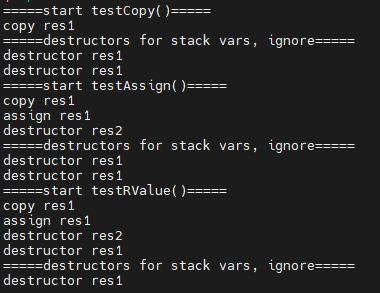- 左值引用和右值引用的区别?右值引用的意义?
左值引用是对左值的引用,右值引用是对右值的引用。
功能差异:左值引用是为了避免对象拷贝,如函数传参、函数返回值。右值引用是为了实现移动语义和完美转发。
怎么区分左值和右值?
左值可以在等号的左边,可以取地址,具名,比如:变量名、返回左值引用的函数调用、前置自增自减、赋值运算或符号赋值运算、解引用。
右值只能在等号的右边,不能取地址,不具名,右值有纯右值,比如字面值、返回非引用类型的函数调用、后置自增自减、算术逻辑比较表达式,右值还有将亡值,主要为C++11新引入的与右值引用(移动语义)相关的值类型,可以通过move把左值强制转换成将亡值,将亡值将用来触发移动构造或移动赋值构造,并进行资源转移,最后调用析构函数。
const的左值引用可以指向右值,但不能修改这个值。右值引用可以通过std::move可以执行左值。声明出来的左值引用和右值引用都是左值。
移动语义是为了对象赋值时,避免资源的重新分配,比如移动构造和移动拷贝构造,stl的unique_ptr也有用到。
完美转发指的是,函数模板可以将自己的参数完美的转发给内部调用的其他函数,完美指的是不仅能转发参数的值,还能保证转发时参数的左右值属性保持不变。
借用万能引用,通过引用的方式来接收左右参数的值。万能引用折叠的原则:参数为左值或者左值引用,T &&将转化为int &(假设传进来的值为int类型),参数为右值或者右值引用,T &&将转化为int &&,std::forward(v),T为左值引用,v将转化为T类型的左值,T为右值引用,v将转化为T类型的右值。 1
2
3
4
5
6
7
8
9
10
11
12
13
14
15
16
17
18
19
20
21
22
23
24
25
26
27
28
29
30
31
32
33
34
35
36
37
38
39
40
41
42
43
44
45
46
47
48
49
50
51
52
53
54
55
56
57
58
59
60
61
62
63
64
65
66
67
68
69
70
71
72
73
74
75
76
77
78
79
80
81
82
83
84
85
86
87
88
89
90
91
92
93
94
95
96
97
98
99
100
101
102
103
104
105
106
107
108
| #include <stdio.h>
#include <string>
#include <algorithm>
using namespace std;
class ResourceOwner
{
public:
ResourceOwner(const char res[])
{
theResource = new string(res);
}
ResourceOwner(const ResourceOwner &other)
{
printf("copy %s\n", other.theResource->c_str());
theResource = new string(other.theResource->c_str());
}
ResourceOwner(ResourceOwner &&other)
{
printf("copy2 %s\n", other.theResource->c_str());
theResource = other.theResource;
other.theResource = nullptr;
}
ResourceOwner &operator=(const ResourceOwner &other)
{
ResourceOwner tmp(other);
swap(theResource, tmp.theResource);
printf("assign %s\n", other.theResource->c_str());
}
ResourceOwner &operator=(ResourceOwner &&other)
{
theResource = other.theResource;
other.theResource = nullptr;
printf("assign2 %s\n", theResource->c_str());
}
~ResourceOwner()
{
if (theResource)
{
printf("destructor %s\n", theResource->c_str());
delete theResource;
}
}
private:
string *theResource;
};
void testCopy()
{
printf("=====start testCopy()=====\n");
ResourceOwner res1("res1");
ResourceOwner res2 = res1;
printf("=====destructors for stack vars, ignore=====\n");
}
void testAssign()
{
printf("=====start testAssign()=====\n");
ResourceOwner res1("res1");
ResourceOwner res2("res2");
res2 = res1;
printf("=====destructors for stack vars, ignore=====\n");
}
void testRValue()
{
printf("=====start testRValue()=====\n");
ResourceOwner res2("res2");
res2 = ResourceOwner("res1");
printf("=====destructors for stack vars, ignore=====\n");
}
ResourceOwner getRO()
{
ResourceOwner res1("tmp");
return res1;
}
void testFuncReturn()
{
printf("=====start testFuncReturn()=====\n");
ResourceOwner res2("res2");
res2 = getRO();
printf("=====destructors for stack vars, ignore=====\n");
}
int main()
{
testCopy();
testAssign();
testRValue();
testFuncReturn();
}
|

加了移动语义后:

返回值不需要std::move,编译器会进行返回值优化。

- C++11智能指针以及使用场景?
指针管理的困境:资源释放了,指针没有置空,比如野指针(资源释放了,但没有置为nullptr,还在继续使用)、指针悬挂(多个指针指向同一个资源,其中一个指针释放了资源也置空了,但是其他的指针并不知道)、踩内存(拿着野指针去修改新分配的资源);没有释放资源,产生内存泄漏;重复释放资源,引发coredump;
通过RAII的方式来解决,有shared_ptr、weak_ptr和unique_ptr。
unique_ptr 类似于一个独占所有权的指针,只能有一个指针管理一个对象,当 unique_ptr 被销毁时,它所管理的对象也会被随之销毁。它的定义和用法如下:
1
2
| std::unique_ptr<int> ptr(new int(10));
std::cout << *ptr << std::endl;
|
shared_ptr 是一种共享所有权的指针,多个指针可以同时管理一个对象,当最后一个 shared_ptr 被销毁时,它所管理的对象才会被随之销毁。它的定义和用法如下:
1
2
3
| std::shared_ptr<int> ptr1(new int(10));
std::shared_ptr<int> ptr2 = ptr1;
std::cout << *ptr1 << " " << *ptr2 << std::endl;
|
weak_ptr 是 shared_ptr 的一种扩展,它可以不增加所管理对象的引用计数而与 shared_ptr 交互,但它不能直接访问所管理的对象,需要通过 lock() 函数获得一个指向所管理的对象的 shared_ptr。通常用于解决 shared_ptr 循环引用的问题。它的定义和用法如下:
1
2
3
4
5
6
| std::shared_ptr<int> ptr(new int(10));
std::weak_ptr<int> wp = ptr;
if (!wp.expired()) {
std::shared_ptr<int> ptr2 = wp.lock();
std::cout << *ptr2 << std::endl;
}
|
- lambda表达式,如下,x相当于默认是加了const的,如果要修改,需要加mutable
1
2
3
4
| auto f = [x] () mutable {
x = 2;
std::cout << x << std::endl;
};
|
constexpr 是在 C++11 标准中引入的一种修饰符,用于声明一个在编译时就能确定其值的表达式或函数,其运行速度可以相当于直接写出该值。由于在编译时就能确定值,因此 constexpr 可使编译器为编译期计算并优化表达式。
1
| constexpr int k = 5 * 7;
|
简述shared_ptr
- shared_ptr 实现共享式拥有概念,多个智能指针可以指向相同对象,该对象和其相关资源会在“最后一个引用被销毁”时候释放。从名字 share 就可以看出了资源可以被多个指针共享,它使用计数机制来表明资源被几个指针共享。
- 可以通过成员函数 usecount() 来查看资源的所有者个数,除了可以通过 new 来构造,还可以通过传入autoptr, uniqueptr,weakptr 来构造。当我们调用 release() 时,当前指针会释放资源所有权,计数减一。当计数等于 0 时,资源会被释放。
- sharedptr 是为了解决 autoptr 在对象所有权上的局限性 (auto_ptr 是独占的),在使用引用计数的机制上提供了可以共享所有权的智能指针。


